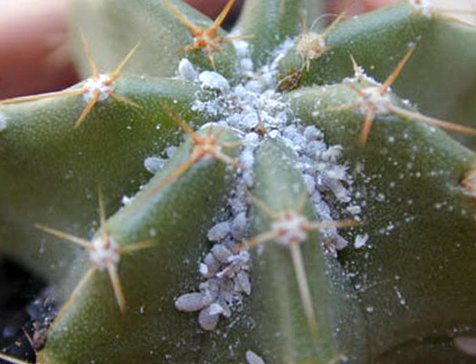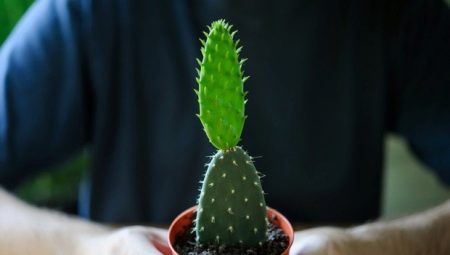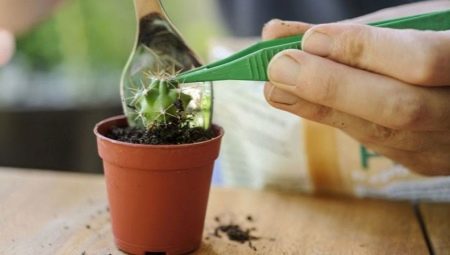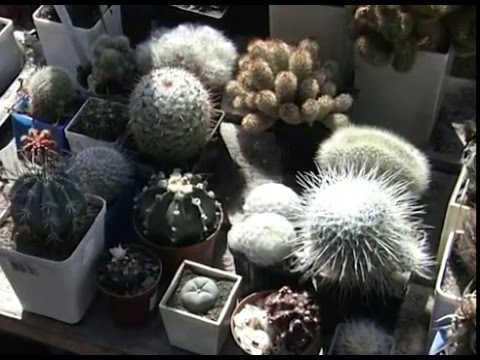What to do if harmful insects are found
How to deal with ticks

Spider mites can be easily identified by their characteristic white coating
Most often, it is ticks that harm cacti. The result of their activity - a plaque that looks like rust - is, unfortunately, almost impossible to remove: stains remain on the plant even after recovery.
Ticks are not affected by conventional insecticides. It is supposed to process the cactus with other substances - acaricides. But even with them, not everything is so simple: most ticks quickly develop immunity to poisons. The surviving pests after the first treatment may not even notice the exposure to the hazardous substance during the second procedure. Therefore, use powerful drugs such as:
- Actellik;
- Neoron;
- Fufanon;
- Apollo;
- Oberon.
Dilute the product according to the manufacturer's instructions and thoroughly spray the entire cactus stem and soil with the solution, especially in the root zone. To consolidate the effect, carry out the treatment twice with different means. The interval between procedures is 1 week.
For prophylactic purposes, wipe a healthy plant with a solution of acetone and alcohol, taken in a 1: 2 ratio. It is most convenient to use a brush for this.
Mealybugs and other plaque-leaving bugs

Root bugs are similar to mealy bugs, but are located exclusively at the root system
To combat worms, it is better to use systemic drugs. Water the soil in which the cactus grows with a solution of Confidor or Aktara. The roots absorb the active substance well, which has a detrimental effect on the worms, and distribute it throughout the plant.
In case of local concentration of pests - on the roots and root collar - use the so-called root baths. Soak the roots of the plant in hot water for 15 minutes (the optimum temperature is 50–55 ° C). You can also rinse them in Actellik's solution (the dilution method is indicated in the instructions), but no more than 5 minutes.
Experienced cactus breeders recommend doing this (the sequence of actions must be strictly followed):
- Rinse the roots thoroughly to remove the worm. Start with lukewarm liquid and add hot liquid constantly (water must be running). There should not be a single white spot left.
- Lather the roots with a cleanser such as Fairy. Soak them in the lather for about 10 minutes, then rinse thoroughly.
- Dip the roots in a very strong Fitoverm solution and leave in it for 15 minutes.
- Then dry the cactus.
- Throw away all the contaminated soil, pour boiling water over the pot, wash thoroughly with a cleaning agent.
- Plant the dried cactus in a new substrate with the addition of 2 packs of crushed activated carbon, a small amount of perlite and vermiculite.
- Water the rest of the cacti with Fitoverm (if you are growing several of these plants).
- Put the cured flower back in place.
Shields and false shields, due to which the cactus stops growing
To get rid of the scabbard, remove it with a cotton swab dipped in rubbing alcohol. If the spines of the cactus are too thick and do not allow such manipulations, water the plant with a solution of Komfidor or Aktara. The pests will die from the effects of systemic insecticides, their bodies will dry out, and you can easily shake them off the cactus with a brush. If one treatment was not enough, repeat the procedure after a week.
Root infecting nematoda

Nematodes are so small that they can only be detected by spherical swellings.
You can get rid of the pest by cutting off all the affected parts of the plant. After that, the cactus should be completely treated with alcohol and given a hot root bath. To do this, remove the soil from the roots and immerse it in water with a temperature of 70 ° C for 30–40 seconds. After the procedure, the root system is supposed to be sprinkled with crushed activated carbon.
If you prefer to use chemicals, choose an imidacloprid-based substance. For example, Confidor's solution is 1 g per 5 liters of water. In addition, Tanrek and Vermitic have proven themselves well (they are divorced according to the instructions). Submerge the entire plant in the solution (both stem and roots) and hold for up to 10 minutes.
To prevent nematodes from emerging, use only a sterile substrate when planting and transplanting. Pre-steam it in boiling water or heat it in the oven for 10-15 minutes at 200 ° C.
Why does the plant stretch upward?
There are several reasons why the cactus begins to stretch strongly:
- Lack of light.
- Incorrect containment temperature.
- Lack of nutrients.
- Incorrect transfer time.
But it also happens that all the rules of cultivation are observed, and the plant continues to stubbornly grow upwards. This means that the cactus belongs to a species that must reach a certain length in length.
These types include:
- cereus;
- aporocactus;
- prickly pear.
If the cactus, by its nature, must grow proportionally, then the growing conditions must be revised.
Lack of light
There is a misconception that a cactus can grow in any conditions. Far from it.
Attention! If the plant lacks light, it will try to receive it by any means, including stretching upward.
In order to help the plant regain its natural shape, you need to place it in a well-lit area.
Temperature
The life cycle of a cactus consists of two phases: a period of active growth and formation of green mass and a dormant period. The first cycle occurs in summer and autumn. At this time, the temperature of the content should be 20 - 30 degrees above zero.
When the plant goes into hibernation and a dormant period begins, it is better to place it in a cool place where the temperature does not exceed 15 degrees. Otherwise, it will continue to grow exclusively upward.
In order for the plant to feel comfortable, it is necessary to observe the correct temperature regime, based on the life cycle of the cactus.
Illumination and temperature conditions are directly related, so if a cactus is kept in a very warm place, it will certainly begin to stretch.
Transplant time
Transplantation is one of the most important events in the life of any plant and cactus as well. If this procedure is carried out incorrectly, you can greatly harm or even destroy the plant (you can find out about what can cause the death of a cactus and how to understand that the plant is dying here).
Adult cacti are transplanted in winter, young ones in spring.
Important! If you do not follow the seasonal conditions of transplantation, then an adult cactus transplanted in the spring will acquire an unpresentable appearance, stretching out strongly upward.
Incorrect feeding
Of course, it is necessary to fertilize the soil. But you need to observe a sense of proportion. This is especially true for nitrogen-containing fertilizers. The fact is that nitrogen affects the growth of the plant. With a large amount of it, the cactus will grow disproportionately. If this happens, then it is better to change the soil in which the plant resides.
Lack of nutrients will cause the plant to stretch out, become thin and depleted. In order to help the plant, you will need to use soil fertilizers, which are easily obtained from a specialized store.
Mottling
Spots are caused by physiological factors, parasites and harmful bacteria. Most often, it is the latter that are the cause.
Spots can take the form:
- rusty streaks;
- brown spots;
- dark plaques;
- cortical growths;
- translucent mosaic stains;
- raised green or red specks;
- depressed spots.
Unlike rot, cutting them off is useless: spots will appear in new places, even if old ones have been removed. Deters infection by periodically spraying with fungicides, such as Topaz
It is important to strengthen the plant's immunity by placing it in a dry, sunny place. The spots will not disappear from this, but they will stop growing, and moreover, new ones will not appear.
However, if you notice dry spots of light or dark brown color on a cactus, this is most likely brown spot (anthrocnosis) - a fungal disease, and in order to save the plant, you need to remove the spots and treat with fungicides according to the standard scheme.
Problems associated with excessive sunlight
But there is another problem - sunburn. This happens when plants are exposed from a shady window sill on a sunny terrace in direct light. At first, the plant may get spots, and if the plant is kept in the sun for a long time, it may dry out completely. From the active sun in the summer, it is recommended to shade succulents with a light cloth.
Sometimes the bright sun has a detrimental effect on plants that come out of the period of winter dormancy. It is necessary to gradually accustom succulents to the light, taking out the first days in the sun in the afternoon for only an hour or two. Increase the time gradually. And only after that, the plants can be left for the whole day, but on especially hot days you need to make a shade curtain. Burns appear as brown spots, erosion of the upper layer of the leaves. Traces similar to scars remain on the Decembrist.
 Sunburn
Sunburn
How to save a sick cactus
The flower dies from rot or spotting
If the root system of a cactus is affected by rot, you can do two things.
- At the first stage, with partial decay, remove all damaged rhizomes. Thoroughly sprinkle the rest with sulfur or crushed activated carbon. Transplant the plant into a fresh, pre-sanitized medium with plenty of sand. After such a procedure, the first watering should take place after 3 weeks.
- When the entire root system decays, root the upper part of the stem, taking it as a cutting and cutting off everything that is down to healthy tissue. If the rot begins to get to the root collar or trunk, it will be possible to save only the top of the plant by grafting onto a healthy cactus.
In some cases, decay can begin with a wound that appears from mechanical damage on the skin of a cactus. Until the lesion has grown, cut off the damaged tissue with a sharp knife and sprinkle the cut with sulfur. A slight scar will remain in place of the small wound when the plant recovers.
If rotting starts from the crown, remove it to healthy tissue. Sprinkle all wounds with sulfur (you can also use crushed activated carbon) or grease with green stuff for disinfection. In this case, the cactus can only be used as a rootstock for grafting a healthy plant.

Such spots that appear with black rot are supposed to be cut off with a knife.
Having found black rot on the surface of the cactus, immediately cut out all the spots with a sharp knife to healthy tissue. Sprinkle the sections with sulfur, treat the plant completely with Hom, Oxychom or Fundazol.
Since dry rot, as already mentioned, makes itself felt too late, if it is found, the cactus will have to be destroyed. But infection can be avoided by periodically spraying or watering the plant with a systemic fungicide for prophylaxis.

Dry rot leads to the complete drying of the inner tissues of the cactus
Spots of various types are most often caused by microorganisms that have become accustomed to the plant due to poor conditions. First of all, such a reaction is caused by a draft, especially in cold weather with high humidity.
Sunburn or cold water droplets on the surface of a cactus can cause stains such as rust. Its peculiarity is that the spots are almost impossible to remove and quickly spread over the entire surface of the plant. To contain the development of the disease, periodically spray the flower with the Topaz fungicide. Do not try to remove stains by cutting out; rough scars will remain in their place.
Fungi are afraid of dry air, bright light and heat. Try placing an infected cactus (if the disease is detected early) on a well-lit windowsill in a warm, dry room. There is a high probability that under such conditions and moderate watering, the plant will heal on its own.
If you find anthracnose (brown spot), arm yourself with a sharp knife and carefully remove the damaged areas to healthy tissue. Treat the cut sites with fungicides.

Brown crusty spots - signs of brown spotting
But a cactus affected by brown rot is unlikely to be saved. The fact is that it is not possible to detect the disease immediately, the symptoms appear when the plant is already dying. Unfortunately, in this case, the flower will have to be thrown away, and the pot remaining from it must be thoroughly disinfected.

With brown rot, the cactus begins to rot from the root collar
The plant withers from the virus
Diseases caused by viruses do not affect cacti very often. It is not difficult to identify them. The only exceptions are cacti with very dense thorns: under them, the changes are sometimes not so noticeable.
With ailments, a pattern appears in the form of concentric rings or spots located in a certain sequence (there is no chlorophyll in these places). For example, small specks may be scattered all over the stem, as if acid had been sprayed on the cactus. Most often, the florist takes such marks for sunburn after spraying. But if the procedure was not carried out or the plant is in a place inaccessible to the sun's rays, then the matter is in the virus.
To cure a cactus, try over-the-counter antiviral medications for people. A solution of remantadine is well suited (1 tablet of medicine is taken for 0.5 liters of water). Water and spray the plants with it as the soil in the pot dries.
Protection against diseases and pests
Maintaining an optimal microclimate and providing the necessary care depending on the species and growing season are the main ways to protect the cactus from damage.
Caring for a cactus involves:
- watering after the soil has dried;
- applying dressings in the spring and summer;
- ensuring the wintering period;
- timely transplant.
Noticing signs of ill health, you should correctly establish the cause. For example, on cacti, mealybug can be confused with various diseases accompanied by the appearance of spots. Removing the insect leaves a damp spot on the whole skin.
When growing cacti at home, the succulent may be affected by infections and harmful insects. Measures should be taken immediately, since symptoms often appear late, there is little time left for the plant to rescue. The best protection is preventive measures.
I am dealing with cacti. First, show a photo. Conversation about nothing.
Then what do you mean turns yellow? Rotting? Where - from below or from above? Perhaps - just an infection. We need a general shot of the cactus and DESIRE a larger plan of yellowness
I tried to "dig" at least something. My laptop is broken, and the main photos are there, alas. Life loves to bring surprises!
What I found is "the remnants of a former luxury." They ended up on another computer. I apologize if I could not show all the beauty of this flower. But believe me, he was amazingly handsome.
Don't cry - you can and should learn from mistakes!
Photos received.What to say? Sincere advice - do not suffer and throw it in the trash! Rough, but true! I answer why.
For starters: you poured it and this is unambiguous. Firstly, he had a nasty wintering and not one
Notice how ugly his growth is. In the beginning, the cactus was "plump", and then its body narrowed and stretched out like a worm
What does this mean? The cactus should hibernate - and he is resting at this time. He should artificially lower the temperature to 10 degrees Celsius and DO NOT WATER. Voobshe! There are different opinions on this, but this is how I do it. I have more than 300 cactuses, so believe me. During hibernation, the cactus assimilates the growth and lays the buds. Do you want it to bloom? What did you do? The cactus hibernated, but! They continued to water it. And instead of sleeping - with his last strength he continued to reach for the light and grow. We see this negative growth in the photo. It is impossible to get rid of him, he will not go anywhere. You can cut it, but you will lose the growth point of the cactus - this is not an option. Therefore: there will be no beauty from him, this is for sure - for scrap. This is the first mistake that happens.
About his death. The photo shows that the lower part of the stem is yellow. But you didn't explain - is it soft? To do this, you do not need to squeeze the cactus stalk with your fingers. If it is soft, you will feel it right away. If it is soft, it is rot. You wrote that you pruned the roots, as this is one of the ways to combat rot. Perhaps I paraphrased a little, sorry. If the cactus is rotten, then it is not the roots that are cut off, but the STEM OF THE CACTUS. HIS BODY! And they cut until the stem of the cactus, or rather its trunk (the white circle in the middle) becomes SINCERELY white - healthy! Then, the rest of it can be rooted. And this is a completely different story!
Let's say you cut. Crush an activated charcoal tablet and sprinkle on the wound. Place it on the windowsill, the wound should heal. Nothing will happen to him. Make a circle of cardboard to cover a small cup. Cut a hole inside the circle and place a healthy piece of cactus in it (one week after surgery). He should not touch the water, he should hover over it. Everything in this world is drawn to water - in 10 days the roots will stretch too. You need to wait. Then put it on the prepared ground and roll it with small pebbles, if any. If not. Just make a hole in the ground and place a cactus in it. It is not necessary to sprinkle it with earth. He will strengthen himself.
Watering in the summer once a week. As the earth dries up. Better underfilling than overflowing. Watering starts in April, ends in October. Between these months there is rest: little light, low temperature and lack of water.
That's all I could tell from the photo and your data, what you wrote.
Pests
At home, insects rarely damage a cactus, especially with good immunity. Pests can be divided into those affecting the roots and the aerial part. The latter are more common, more noticeable on fleshy stems. The vital activity of insects can be determined by a yellowed fleshy stem, a whitish bloom, various specks and depressions, a thin cobweb.
The most common pests of cacti:
- aphid;
- spider mite;
- mealybug;
- shield;
- root felt.
Aphid
This small insect lives in colonies and multiplies rapidly. Pests of cacti feed on sap from young shoots and buds, which leads to wilting and death. You can destroy them by washing off the stem with soapy water or a solution of potassium permanganate. It is undesirable to use only this method, since it is possible that the larvae or adults will remain. From biological methods, a solution of ammonia, tobacco is used. In severe cases, spraying with special insecticides approved for home use should be carried out.

Spider mites
They get on the cactus from other plants, prefers fleshy varieties - echinopsis, chamecereus, rebuts. They are an insect 0.4 mm in size, slowly moving, but rapidly multiplying. A favorable environment for the life of the pest is high temperature and dry air. It gnaws at the skin and sucks out the sap of the plant. A sign of damage is brown spots on the stem, a light cobweb. The damage caused by the spider mite is not repaired.
To combat, regular spraying is carried out from a spray bottle. If possible, it is advisable to wipe the stem with soapy water, alcohol, garlic tincture. Additionally, you can process karbofos, nearon, cyclamen, various compositions according to folk recipes. Spraying with a solution of ether sulfonate is considered the most effective.

Mealybug
Another name is shaggy aphid. The pest is white, 0.5-0.7 cm long, settles in the folds of the stem or around the thorns, where water does not get. It spreads quickly over the surface of the cactus. A sign of damage is a white, cotton-like discharge that serves for oviposition. The most difficult insect to spot is on species that are covered with fluff or hairs.
It is recommended to remove the mealybug from a weakly affected plant with cotton swabs dipped in an alcohol solution. It is permissible to wash off a large colony with a stream of water, having previously covered the soil substrate with a package. Additionally, it is advisable to spray with a chemical that is approved for use at home.

Shields
The insect can be seen by its small flat scales. The color of the pest ranges from red to dark brown. The scale insects feed on the sap of the cactus, leading the damaged specimen to exhaustion and death. They move slowly, almost imperceptibly. A large colony causes sticky secretions to appear on the stem. It is recommended to clean the settlements with a cotton swab dipped in an alcohol solution. In the case of long and densely growing thorns, treat with Aktara or Confidor solution.

Root felt felt
The pest attacks during wintering when the soil is dry. It feeds on the root system, leaves a white cobweb, slightly paler than the roots. You can prevent the death of a cactus with a transplant. The roots should be washed with a solution of dishwashing liquid (1 tsp for 1 liter of water). Transfer the treated plant to a fresh substrate. The use of chemicals is acceptable.

How do the diseases manifest and what are the causes?
Outwardly, the pathology does not become noticeable immediately. First of all, small specks, bloom, cobwebs or discoloration of the stem may appear. Gradually, the condition will worsen, the problem will become more pronounced. In advanced cases, the body of the cactus shrinks, decreases in size, or vice versa, swells, cracks. The appearance of necrotic fetid masses is possible.
As a rule, it is no longer possible to save such specimens. For this reason, you should regularly inspect the plant, analyze the compliance of its growth and development with the given growing season.
The main causes of cactus diseases:
- physiological;
- fungus;
- bacterial damage;
- viral infection;
- pests.
Physiological diseases
Disorders in care are the cause of this kind of disease. The result is: bud fall, root decay or burns.
Suberization
Description:
Corking does not interfere with plants, it can be a symptom of errors in cultivation, the result of the natural life cycle of the plant, in prickly pear, thus, aging of the epidermis manifests itself.
Photo:



Treatment:
If corking is caused by errors in cultivation, you need to move the pot to a lighter spot and consider if the disease is the result of over-fertilization. You can rejuvenate the plant by cutting off the top and rooting it, then the corking will "disappear".
Kidney collapse
Description:
Falling buds in cacti are caused by a lack of moisture in the room, low temperatures and a lack of fertilizer.
Treatment:
The most common reason is to rearrange the pot, the plant should stand in one place during flowering, facing the sun.
Burns
Description:
Illness is caused by: Excessive sun exposure, poor indoor or outdoor airflow, and excessive heat. Burns most often appear on cacti in the summer on a windowsill in an unventilated room. A distinctive feature of burns are white spots that do not disappear even after a few years. The disease affects cacti at the moment when plants are transferred from a dark place to a bright one.
Photo:


Treatment: To cure burns on cacti, protect from excess sun, after the wintering period, gradually accustom to a brighter place.
Chlorosis
Description:
Chlorosis causes the disappearance of chlorophyll in plant tissues. It manifests itself in yellow or yellow-green shoots. The disease causes a lack of iron and magnesium in the soil.
Photo:


Treatment:
To prevent the development of the disease, even at the first symptoms, it is worth fertilizing the cacti with fertilizers rich in the above-described components.
Lack of gain
Description:
The plant stops growing as a result of improper care. For example, poor fertilization, insufficient watering. These omissions cause no gain.
Treatment:
To cure the plant, it is worth transplanting it into new soil, fertilizing it accordingly and watering it abundantly.




















































